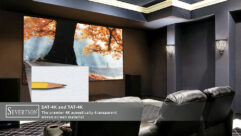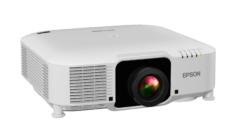
Picture This: Video Technology at CEDIA
Oct 1, 2008 12:00 PM,
By Jeff Sauer
Better image quality abounds at CEDIA Expo 2008.

One of the most stunning flatpanels at CEDIA was Hitachi’s 1.5in. thin plasma with a free-standing white base and chassis. It was only a prototype with no pricing or delivery information available, but the thickness matches that of Hitachi’s line of 1.5in-thick LCD TVs, which were introduced at CES and are now shipping.
The slow economy dragged attendance at CEDIA Expo 2008 down by a reported 14 percent from last year. But it didn’t stop manufacturers from driving video technology forward. This year, the themes were better black levels, higher contrast, and just straight image quality in front projection and ultra-thin flatpanels, with LED getting into the act with both sectors.
1080P PROJECTORS AND BEYOND
With 1080p resolution now established as the default resolution for home-theater projection, manufacturers at CEDIA focused on other metrics such as contrast, black levels, and image processing. For example, the PowerLite Pro Cinema 7500UB (Ultra Black) became the new top of Epson’s home-theater line with new features such as anamorphic scaling, color space selection, a 120Hz frame rate, built-in ISF calibration tools, and a surprising dynamic contrast ratio of 75,000:1. The 7500 will be available in December for less than $5,000, while the PowerLite Pro Cinema 7100UB — with more modest image processing, no anamorphic scaling, and no ISF tools — will be less than $3,000 when it ships in November. Epson’s PowerLite Home Cinema 6500 and 6100 (non-Ultra Black) 1080p models will also be available later in the year, with the 6100 priced less than $2,000.
The HC7000U is the new flagship of Mitsubishi’s new Diamond series, leveraging Mitsubishi Consumer’s higher-end HDTV brand. At $3,995, it will also feature a high dynamic 72,000:1 contrast ratio, HQV Reon video processing, very low fan noise, and an elegant near-black royal-purple chassis. It also supports anamorphic lens options.
Although it’s expected to ship at the end of October, Panasonic’s new PT-AE3000 was curiously not on the show floor — only being shown in an invite-only demo suite. Too bad, because it was worth the look. It has exceptional grayscale depth, a dynamic contrast of 60,000:1, noticeably improved second-generation detail enhancement, and a clever lens-memory feature that saves two lens positions for 16:9 and 2.35:1 viewing. Panasonic also incorporated the 120Hz frame rate and frame interpolation (including quadruple frames for 24p material) we’ve come to expect from LCD panels. Interestingly, in addition to the expected smooth motion, this 120Hz also afforded a more vibrant, near-3D look. The AE3000 will be priced at $3,499.
A new company, Wolf Cinema, is trying to claim the ultra-top-of-the-line home-theater market once controlled by Runco with six models ranging from $60,000 to $117,000. There are actually three models, each available as either “installation” (designed to be built into a cabinet by an installer) or “full dress” (standalone). All models offer 14-bit processing and thermal cooling, as well as Variscope lens options.
Projectiondesign’s new avielo series includes the 3-chip DLP helios and two single-chip, RGBCYM-color-wheel models: spectra and radiance. All three of these avielo models are native 1080p, although the avielo prisma is 720p.
JVC introduced two upgrades to its existing line of D-ILA models. The DLA-HD350 and DLA-HD750 (to be sold by JVC Professional as DLA-RS10 and DLA-RS20, respectively) will be available in November for $6,000 and $8,000, respectively. They feature native (non-dynamic) contrast of 15,000:1 and 30,000:1, as well as HQV Reon image processing and THX certification.
A distinct exception to the overwhelming 1080p trend was JVC Professional’s 4096×2400 native DLA-SH4K, using JVC’s industry-smallest 1.27in. 4K imaging devices and shown off the show floor in JVC Professional’s D-ILA theater.
Picture This: Video Technology at CEDIA
Oct 1, 2008 12:00 PM,
By Jeff Sauer
Better image quality abounds at CEDIA Expo 2008.
Two more projects that were not on the show floor offered an intriguing look at the future. Both Digital Projection and Asian OEM supplier Chi Lin showed lamp-free 1080p projections. Production models are as much as a year away, and current brightness was limited to 500 lumens to 600 lumens, but these LED-lit projectors boast remarkable color accuracy and contrast. I would expect higher brightness by the time they are ready.
THIN FLATPANELS
One of the most stunning flatpanels at CEDIA was Hitachi’s 1.5in. thin plasma with a free-standing white base and chassis. It was only a prototype with no pricing or delivery information available, but the thickness matches that of Hitachi’s line of 1.5in-thick LCD TVs, which were introduced at CES and are now shipping.
Panasonic’s new TH-65VX100U 65in. plasma touts “ultimate black,” with a contrast ratio of 60,000:1. Unfortunately, the new series won’t be available until the CES timeframe next January. Still, between Hitachi, Panasonic, and Pioneer’s recent announcements, plasma seems to be hanging around as a very viable flatpanel choice.
Joining Samsung, which showed its second-generation 950 series LED-backlit LCDs, Sharp and Sony each introduced their own LED-backlit LCD TV series. Sharp’s 52in. and 65in. Aquos are said to reach 150 percent of the NTSC color gamut, with a dynamic contrast of 1,000,000:1 (thanks to the ability to literally turn off the LEDs). Leveraging a separate AV module allows Sharp to limit the panel depth to just 1in., while still offering five HDMI inputs, plus standard analog video inputs. Sony’s new 40in. and 52in. Bravia LCD TVs are even thinner at just 9.9mm thick. More uniquely, Sony has quadrupled typical frame rate to 240Hz, interpolating as many as three frames.
Toshiba’s new higher-end Regza line of LCDs includes built-in upconverting to give standard-definition DVDs and cable/braodcast television a near-HD appearance. That built-in Super Resolution Technology (SRT) actually comes directly from the ill-fated HD DVD disc format (which lost to Blu-ray Disc in its attempt to become the next-generation HD version of today’s DVD). Toshiba’s XDE is basically the same upconverting technology as SRT, but it’s built into Toshiba’s new line of DVD players, enabling them to output interpolated 1080p from standard-definition DVDs.
Mitsubishi’s consumer-television division announced laser-lit televisions more than a year ago, and it appears that the 65in. LaserVue is finally ready to ship this month. Pricing has been set at $6,999 — which is, thankfully, down from the five-digit pricing Mitsubishi was first offering. The 65in. LaserVue will be just 10in. thick. That’s very good for an RPTV, but it still faces thinner form factors and falling prices from plasma and LCD makers.
Anchor Bay, maker of the high-end DVDO iScan series of video-processing engines, has a much different take on these new premium televisions. The company suggests you buy as cheap a television as possible and let the new Edge handled all the image processing and scaling. At $799, the Edge is much more affordable than other iScan models, and it has a built-in HDMI hub. It’s also probably less than the cost of a premium-series television that is likely to have had to squeeze image-processing functions down to a chip.









